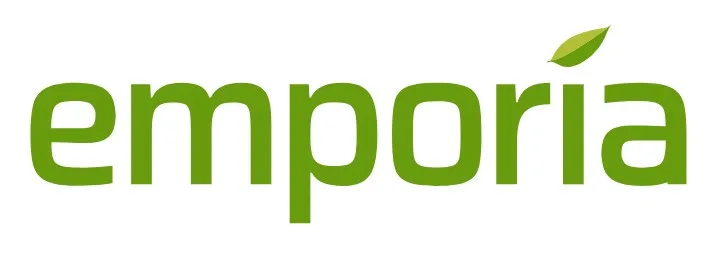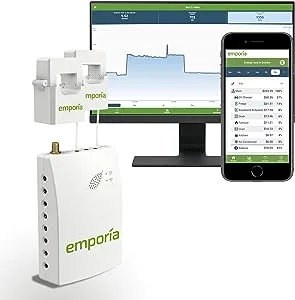With energy prices on the rise and environmental consciousness growing stronger, energy monitors offer a golden opportunity to enjoy dual benefits without breaking the bank. So, what are the best home energy monitors with the best return on investment?
Energy monitors have the potential to slash household energy consumption by anywhere from 6% to an impressive 34%, depending on your usage habits. That’s not just pocket change; it’s significant savings! However, it’s no secret that these little gadgets can come with a hefty price tag.
The secret sauce to finding the best home energy monitor lies in securing one that strikes the perfect balance between cost and functionality, while also presenting data in a way that suits your preferences. So, let’s dive in and explore your best options.
Learn More: What is a Home Energy Monitor
Our Top 3 List
Best Overall

- Machine Learning
- Easy Installation
- Costs less than comparables
Best "Do It All"

- Machine Learning
- Easy Installation
- Great Visuals
- Compatible with Solar
Best Value

- 1/4 the Cost
- More Cables for Individual Detection
- Integrates with Smart Plugs
What to Know Before you Buy
What Makes the Best Home Energy Monitor for You?
The term “best” varies from individual to individual when it comes to home energy monitors. For example, I personally use the Sense Home Energy Monitor in my home, but I would recommend the Generac PWRview W2 to others.
One important thing for me was that the interface was excellent and easy for data analysis because I was using the data for studying and reporting on our home. However, this might not be the need of others. So let’s go through the key features that might make the best home energy monitor for you.
Here are some key features that contribute to making a home energy monitor the best. Then I will discuss how each monitor performs in these categories in their individual sections below:
Accuracy: The monitor should provide accurate measurements of energy consumption for individual appliances, circuits, or the entire home. Precision is essential for understanding where your energy is being used and how to make effective changes. Generally, all of the home energy monitors are very accurate, but if you are looking for exact numbers on one appliance then the monitors with machine learning may have limitations.
Real-time Monitoring: The monitor should offer real-time data, allowing you to see immediate changes in energy usage when you turn on and off appliances, or adjust settings.
User-Friendly Interface: The monitor’s interface should be intuitive and easy to understand. It should display data in multiple ways, each that is clear to users of all tech-savviness levels.
Remote Access: The ability to access data remotely for monitoring usage for emergencies when you are on vacation, or even for bumbling around the house flicking on and off switches like a mad person to find that huge energy vampire of a crockpot.
Appliance-Level Monitoring: The best monitors allow you to monitor the energy consumption of individual appliances. Usually, this comes in the form of machine learning or extra cables to hook directly from your devices to the monitor.
Historical Data: The monitor should store historical data, enabling you to track trends and patterns in your energy usage over time. This information is valuable for making long-term energy-saving strategies, seeing the environmental and economic changes you have made, and understanding trends.
Alerts and Notifications: A good energy monitor can set up alerts and notifications based on predefined energy usage thresholds. This can help you avoid energy wastage or abnormal usage that might indicate a malfunction, or shoot to use big energy users at times when energy costs are lower.
Integration with Smart Home Systems: Compatibility with smart home platforms like Google Home, Amazon Alexa, or Apple HomeKit can enhance the monitor’s functionality and make it easier to integrate energy management into your daily routine.
Data Export and Analysis: The ability to export energy usage data in various formats (CSV, Excel, etc.) can be valuable for those who want to perform in-depth analysis or integrate the data with other tools.
Energy-Saving Recommendations: Some monitors go beyond just displaying data and offer personalized energy-saving recommendations based on your usage patterns. These recommendations can help you take specific actions to reduce consumption.
Easy Installation: A simple and straightforward installation process is crucial. Monitors that require minimal wiring or professional installation tend to be more user-friendly. However, you will be working with big power outputs! Make sure to read the instructions carefully, consider consulting an electrician for safety or insurance purposes, and BE SAFE! See our article on what a home energy monitor is for a general description of installation.
Compatibility: Ensure the monitor is compatible with your electrical system, whether you have a single-phase or three-phase electrical setup.
Data Security: Since the monitor collects sensitive data about your home’s energy usage, it’s important to choose a product that takes data security seriously and employs encryption and other security measures.
Support and Updates: Opt for a monitor from a reputable manufacturer that offers good customer support and regular software updates to ensure the device remains functional and up to date. All of the best home energy monitors recommended in this article are at the top of the list for support.
Cost: I put cost last here because I think you want to prioritize the other features first and then consider the cost. A home energy monitor is likely to save you money. Ideally, you want one that provides you with the features you want, so you can then effectively recoup the cost by having it work with you.
What household items typically use the most energy?
As a general rule; movement (e.g. fans) and light require less electricity, and heat requires more electricity. Here are some examples of typical items that you may be wishing to run using your solar system:
- 10 W - Phone Charger
- 100 W - Mini Fridge
- 125 W - Laptop
- 230 W - Television
- 250 W - Crockpot
- 1500 W - Space Heater
Our List of the Best Home Energy Monitors
Most people are likely looking for a home energy monitor that has machine learning, is slim and easy to install, and has great data output. If that sounds like it fits your bill, then the Generac PWRview is likely your “best home energy monitor”.
It essentially does all the important things that the Sense Home Energy Monitor does but at a lower price.
The Generac PWRview has machine learning, which starts to find appliances around your house based on unique energy signatures. This makes mapping your house significantly easier.
However, machine learning would also be my only negative because it can have a hard time differentiating similar energy signatures from one another, and it can take a while for the monitor to learn these signatures.
- Monitors up to 16 circuits individually
- Easy installation
- Remote data monitoring
- Real-time and historical data
- Regional comparisons and energy saving suggestions
- Compatible with solar system
- Smart home compatible
- Alert options
- Energy saving suggestions
Pros
- Better Price
- Machine Learning
- Great Interface
- Slim
- Easy Setup
- Helpline
- Solar Compatible
Cons
- Machine Learning
Final Verdict
All of the home energy monitors on this list are pretty comparable, but we would rate the Generac PWRview W2 as the best home energy monitor because it offers machine learning, a slim profile, solar monitoring, and easy installation at a great price.
The Sense Home Energy Monitor is the energy monitor that I personally use. It has amazing data visualizations, is ridiculously easy to set up, and has fantastic customer support.
Sense also has monitors that are compatible with solar panels (Sense Solar), and one with dedicated circuit monitoring to help you identify power usage of singular devices (Sense Flex). Dedicated circuit monitoring means you have additional clamps to hook to individual appliances and can be really helpful if you know something is using energy but you can’t find out exactly what and where.
The Sense Home Energy Monitor also has machine learning, which starts to find and suggest labels for appliances around your house based on unique energy signatures. This makes finding each appliance’s energy use a lot easier. However, machine learning would also be my only negative because it can have a hard time differentiating heat-producing similar energy signatures and takes a while to fully map your home.
So if you are looking for a monitor to quickly find individual items, and you are willing to do it manually, then I would suggest the Sense Flex, or the Emporia Gen 2 Vue if you you don’t want machine learning.
- Machine Learning
- 120 day money back guarantee
- Smart plug compatible
- Easy installation
- Remote data monitoring
- Real-time and historical data
- Regional comparisons and energy saving suggestions
- Solar compatible (Sense Solar)
- Dedicated circuit monitoring (Sense Flex)
- Great interface and data access
- App and email alert options
Pros
- Machine Learning
- Amazing Interface
- Easy Setup
- Great Helpline
- Circuit Monitoring with Upgrade
- Solar Compatible with Upgrade
Cons
- Machine Learning
Final Verdict
What can I say other than that I personally chose this energy monitor for my home. In my case, it was the best home energy monitor because of its easy installation, machine learning, solar and single circuit hookups, and amazing data visuals.
If you are looking for a home energy monitor with machine learning, individual appliance hook-ups, and solar compatibility, then no one does all that better than the Sense Flex.
The Emporia Gen 2 Vue gives amazing bang for the buck and is likely your “best home energy monitor” if you aren’t looking for machine learning. It has the possibility of linking to 16 separate circuits which allows you to instantly start collecting data, unlike the other two monitors on this list.
However, this 16-circuit monitoring also makes the system slightly bulky if you are trying to fit it in an already cramped electrical panel (imagine 16 extra wires, clamps, and a little white box jammed next to the rest of your home’s wiring).
Honestly though, for the price difference, we had a hard time not picking this as “Best Overall”. So think carefully if machine learning is something you would prefer.
- Monitors up to 16 circuits individually
- Easy installation
- Remote data monitoring
- Real-time and historical data
- Regional comparisons and energy saving suggestions
- Compatible with solar system
- Smart home compatible
- Alert options
- Energy saving suggestions
Pros
- Instant Monitoring
- Great Interface
- Easy Setup
- Helpline
- Solar Compatible
- Energy Saving Suggestions
Cons
- Bulky
- No Machine Learning
Final Verdict
This monitor offers amazing value. Depending on what you want, its lack of machine learning could be a downside or an upside.
This might be your “best home energy monitor” if you are willing to put in a bit of extra work to gather data in the front end. It provides instant data and individual circuit hookups (which help target single appliances) at a lower price.



